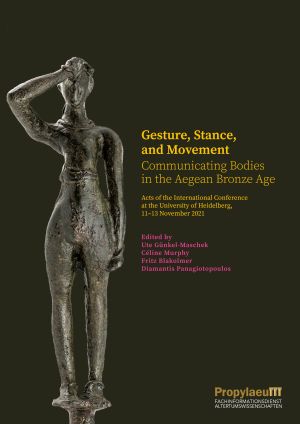
How to Cite
Günkel-Maschek, Ute et al. (Eds.): Gesture, Stance,and Movement: Communicating Bodies in the Aegean Bronze Age. Acts of the International Conference at the University of Heidelberg, 11–13 November 2021, Heidelberg: Propylaeum, 2024. https://doi.org/10.11588/propylaeum.1309
Identifiers
ISBN 978-3-96929-270-9 (PDF)
ISBN 978-3-96929-271-6 (Hardcover)
Published
11/21/2024
Gesture, Stance,and Movement
Communicating Bodies in the Aegean Bronze Age. Acts of the International Conference at the University of Heidelberg, 11–13 November 2021
The meaning of action in figurative imagery is conveyed through bodily posture, placing the depicted figures – humans, gods, or hybrids – in relation within coherent visual narratives. Especially for societies with few deciphered texts, the analysis of gesture, posture, movement, and facial expression is crucial for understanding ancient ‘webs of significance’. With 29 papers from a conference held in Heidelberg in 2021, this volume examines ‘body language’ in Minoan Crete and Mycenaean Greece and proposes new ways of interpreting non-verbal communication in Aegean Bronze Age iconography.
Chapters
Table of Contents
Pages
PDF
I. Frameworks of Analysis for Communicating Bodies
II. Communication Through Expression and Movement
Female Initiation or Non-Narrative Absorption?
119-127
Bodily Movement as Multisensorial Experience in Minoan Cavernous Spaces
129-139
III. Gesture, Posture, and Societal Matters
IV. Of Deities and Humans
243-257
V. Communication in Ritual Action
Reassessing Aegean Bronze Age Depictions of Human and Animal Figures Interacting with a Tree or a Column
291-305
VI. Gesture, Posture, Sex, and Gender
The Neolithic Antecedents of Bodily Comportment in the Aegean
313-333
Applying Sociobiology and Evolutionary Psychology to the Iconography of the Human Body in Bronze Age Crete
351-370
VII. Stances of Triumph, Defeat, and Combat
Body Poses of Victorious and Defeated Warriors in Late Bronze Age Aegean Iconography and Their Egyptian Comparanda
373-378
Emulating the Postures of Near Eastern Rulers and Deities in Aegean Bronze Age Iconography
389-404
VIII. Death and the Communicative Body
Exploring Mortuary Gestures and Their Meaning at the Petras Cemetery, Siteia, Crete
417-423
Re-considering the Potential Identities of Figures on the LM III A2 Agia Triada Sarcophagus
425-430







